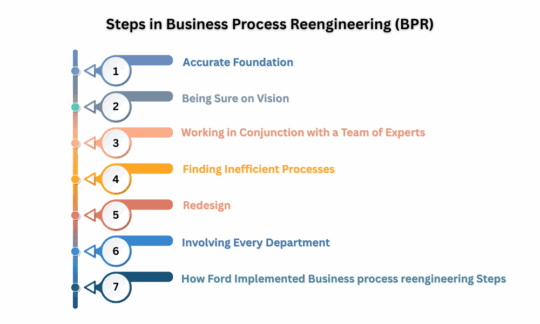Business workflows and their processes leave a lasting effect on business achievements throughout its cycle.
As the business environment changes, the need for restructuring the organization arises as well.
BPR focuses on the upgrading workflows and the processes within an organization while focusing on improving customer services as well as costs.
An accurate foundation is needed when it comes to the reengineering of the business process. This step includes the vision as well as the mission statement too.
Moreover, a clear estimation is also needed as to where the current process is lacking, when it comes to customer satisfaction.
During the Business reengineering process, the vision of the company holds a lot of importance.
It is expected that at this stage, the organization is very much sure about its vision.
This is important as it will decide the fate of the future operations of the company
Understanding the need for BPR implementation is very critical for the organization. As many times such decisions of bringing radical changes in the business process can make employees insecure about their job.
A clear understanding of the vision here plays an important role in convincing the employees for their support.
To implement the reengineering process, it’s best for a company to have internal employees as well as a consultant on the reengineering team.
A BPR team would usually consist of senior managers, operational managers, and reengineering experts.
After selecting the team, the next step includes the complete study of the company itself as to what process the company is currently following.
It also includes a detailed study of its Vision, Mission, the needs of the customers, and how those needs are met.
The main motive behind this study is to evaluate the current process and excluding the non-value adding tasks.
For example, if a company is in manufacturing it involves the study of following points:
• Cycle Time: Evaluating the time spent from beginning to the end of a process.
• Changeover Time: Evaluating the time utilized in making products.
• Defect Rate: Evaluating the overall percentage of defective products manufactured.
The selected team finally works on the implementation of the principles that are going to be applied to the reengineering process.
This also includes the integration of technology into the process.
The checklist for the process analysis would include the following points:
• Reducing the number of handoffs.
• Combine related activities.
• Decrease the number of delays.
• Data centralization.
Companies should review other departments of the business too that would be benefitting because of these changes. Moreover, companies should get feedback from the employees as well.
The main motive here is to keep a track of the effects due to changes in the business process.
Before the Business process reengineering, Ford used to be dependent on 500 people for the accounts payable section.
This process included the purchasing department sending a purchase order to the raw material department
The copy of the same was sent to the accounts payable department which would be dependent on other departments for approval.
Ford was managing this complete process with the help of 500 people.
After opting for BPR with the help of Information Technology Ford was able to counter this issue by implementing an invoice less process.
The new process now included the purchasing department raising purchasing orders and updating it in the database.
After receiving the material, the same would get updated in the database.
Payments were now automatically made unlike earlier where the whole process had to be dependent on the invoice for payment clearance.
You may also like to read:
13 Change management best practices: Every user needs to follow
Business Process Reengineering Advantages and Disadvantages
Business Process Reengineering – Techniques & Tools for Your Business





